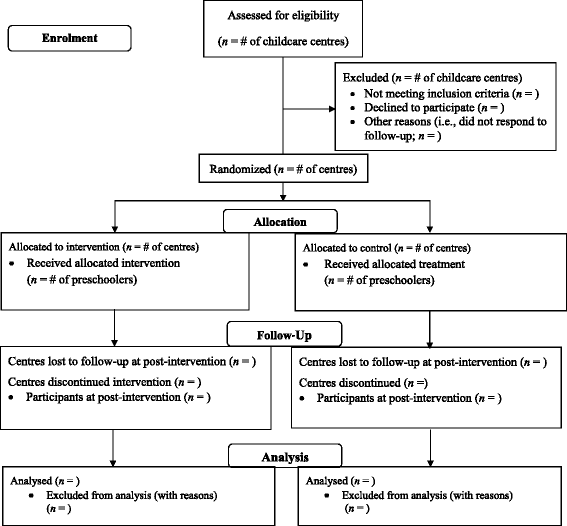Supporting Physical Activity in the Childcare Environment (SPACE): rationale and study protocol for a cluster randomized controlled trial
- PMID: 26842502
- PMCID: PMC4739086
- DOI: 10.1186/s12889-016-2775-9
Supporting Physical Activity in the Childcare Environment (SPACE): rationale and study protocol for a cluster randomized controlled trial
Abstract
Background: Young children are prone to low levels of physical activity in childcare. Researchers have identified that preschoolers tend to be more active outdoors than indoors, with higher activity levels occurring during the first 10 minutes of outdoor playtime. Additionally, interventions incorporating either staff training or the inclusion of play equipment have been effective at increasing children's activity in this setting. As such, the overarching objective of the Supporting Physical Activity in the Childcare Environment (SPACE) intervention is to improve the physical activity levels of preschoolers during childcare hours, utilizing a combination of the above components. The purpose of this manuscript is to provide a detailed account of the protocol, innovative methods, and evaluation plans used in the implementation of the SPACE study; in an effort to support the development of further research in this field.
Methods/design: The SPACE study, a cluster randomized controlled trial, involves 22 childcare centres randomly allocated to either the experimental (n = 11) or the control (n = 11) group. Childcare centres receiving the intervention will adopt an 8-week physical activity intervention with the following components: 1. shorter, more frequent bouts of outdoor playtime (4 × 30 min periods rather than 2 × 60 min periods); 2. new portable play equipment (e.g., obstacle course, balls); and, 3. staff training (1 × 4 hr workshop). Actical accelerometers will be used to assess total physical activity with measurements taken at baseline (i.e., week 0), immediately post-intervention (i.e., week 8), and at 6- and 12-month follow-up. As secondary objectives, we aim to evaluate the effectiveness of the intervention on preschoolers': a) sedentary time; b) standardized body mass index scores (percentiles); c) health-related quality of life; and childcare providers' physical activity-related knowledge and self-efficacy to implement physical activity.
Discussion: The SPACE study aims to increase the low levels of physical activity observed within childcare centres. The findings of this work may be useful to policy makers and childcare providers to consider modifications to the current childcare curriculum and associated outdoor play time.
Trial registration: ISRCTN70604107 (October 8, 2014).
Figures
References
-
- Vanderloo LM, Tucker P, Johnson AM, Burke SM, Irwin JD. Environmental influences on preschoolers’ physical activity levels in various early learning facilities. Res Q Exerc Sport. 2015;19:1–11. - PubMed
Publication types
MeSH terms
Associated data
Grants and funding
LinkOut - more resources
Full Text Sources
Other Literature Sources
Medical
Research Materials


